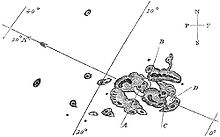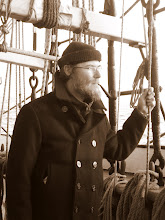In September 1859 there was the largest Geomagnetic disturbance ever recorded.
The
solar superstorm of 1859 was the fiercest ever recorded. Auroras filled
the sky as far south as the Caribbean, magnetic compasses went haywire
and telegraph systems failed.
If such a storm occurred now it could be catastrophic on multiple levels.
Keep your sightglass full, your firebox trimmed, your water iced, and your Faraday cage well grounded
KJ
Solar storm of 1859
From Wikipedia, the free encyclopedia
Sunspots
of September 1, 1859, as sketched by Richard Carrington A and B mark
the initial positions of an intensely bright event, which moved over the
course of 5 minutes to C and D before disappearing.
The solar
storm of 1859, also known as the Solar Superstorm,[1] or the Carrington
Event,[2] which occurred during solar cycle 10, was the most powerful
solar storm in recorded history, and the largest flare, observed by
Richard Christopher Carrington, became known as the Carrington Super
Flare.
Sunspots
From August 28, 1859, until September 2,
numerous sunspots and solar flares were observed on the sun. Just before
noon on September 1, the British astronomer Richard Carrington observed
the largest flare,[3] which caused a massive coronal mass ejection
(CME) to travel directly toward Earth, taking 17 hours. This is
remarkable because such a journey normally takes three to four days.
This second CME moved so quickly because the first one had cleared the
way of the ambient solar wind plasma.[3]
On 1 September 1859,
Carrington and Richard Hodgson, another English amateur astronomer,
independently made the first observations of a solar flare. Because of a
simultaneous "crochet" observed in the Kew Observatory magnetometer
record by Balfour Stewart and a geomagnetic storm observed the following
day, Carrington suspected a solar-terrestrial connection. World wide
reports on the effects of the geomagnetic storm of 1859 were compiled
and published by Elias Loomis which support the observations of
Carrington and Balfour Stewart.
On September 1–2, 1859, the
largest recorded geomagnetic storm occurred. Aurorae were seen around
the world, most notably over the Caribbean; also noteworthy were those
over the Rocky Mountains that were so bright that their glow awoke gold
miners, who began preparing breakfast because they thought it was
morning.[3] People who happened to be awake in the northeastern US could
read a newspaper by the aurora's light.[4]
Telegraph systems all
over Europe and North America failed, in some cases even shocking
telegraph operators.[5] Telegraph pylons threw sparks and telegraph
paper spontaneously caught fire.[6] Some telegraph systems appeared to
continue to send and receive messages despite having been disconnected
from their power supplies.[7]
On September 3, 1859, the
Baltimore American and Commercial Advertiser reported, "Those who
happened to be out late on Thursday night had an opportunity of
witnessing another magnificent display of the auroral lights. The
phenomenon was very similar to the display on Sunday night, though at
times the light was, if possible, more brilliant, and the prismatic hues
more varied and gorgeous. The light appeared to cover the whole
firmament, apparently like a luminous cloud, through which the stars of
the larger magnitude indistinctly shone. The light was greater than that
of the moon at its full, but had an indescribable softness and delicacy
that seemed to envelop everything upon which it rested. Between 12 and 1
o'clock, when the display was at its full brilliancy, the quiet streets
of the city resting under this strange light, presented a beautiful as
well as singular appearance."[8]
Ice cores contain thin
nitrate-rich layers that can be used to reconstruct a history of past
events before reliable observations. These show evidence that events of
this magnitude—as measured by high-energy proton radiation, not
geomagnetic effect—occur approximately once per 500 years, with events
at least one-fifth as large occurring several times per century.[9] Less
severe storms have occurred in 1921 and 1960, when widespread radio
disruption was reported. Another severe solar storm occurred in March
2012, with major disruption possibly limited only to a spacecraft closer
to the Sun than Earth.[10]
Scientific American Slideshow on the 1859 event
"The Carrington Event" September 1859
About Gears, Goggles, and Steam oh My!
Here I collect interesting bits of information related to the world of Steampunk.
Category List
Absinthium
(12)
accessories
(15)
Airships
(69)
Art
(1)
Beakerhead
(3)
Books
(65)
comics
(5)
computation
(11)
costumes
(16)
etiquette
(19)
events
(30)
fiction
(87)
Flight Engineer
(33)
Fun
(57)
games
(36)
history
(109)
howto
(21)
Inventions
(57)
manners
(6)
Meetup Repost
(90)
movies
(4)
music
(4)
Musings
(44)
mystery
(23)
news
(8)
Parasol Duelling
(46)
Photos
(67)
Pie In the Sky
(3)
poetry
(1)
resources
(50)
Role Playing
(59)
Serial Story
(28)
Ships
(39)
Steam
(34)
Steampunk Sports
(26)
Tesla
(13)
video
(77)
website
(57)
What Ifs
(16)



~ 0 comments: ~
~ Post a Comment ~